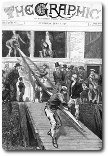Tess of the d'Urbervilles Contents
First publication of Tess of the d'Urbervilles
Serial publication
 Tess was written at the height of Hardy's career. He began preparation for it in 1888, when he was 48 years old. The next year, it began to appear in serial form in The Graphic, a popular family magazine. Its editors were very conservative and kept asking Hardy to tone down the more obviously sexual parts, even objecting to when Angel carries Tess and the girls over a flooded part of the road. Hardy obliged, inventing a wheelbarrow in this particular case. Because of the nature of family reading, late Victorian Britain was still very reluctant to allow any sort of physical description of sexuality in literature.
Tess was written at the height of Hardy's career. He began preparation for it in 1888, when he was 48 years old. The next year, it began to appear in serial form in The Graphic, a popular family magazine. Its editors were very conservative and kept asking Hardy to tone down the more obviously sexual parts, even objecting to when Angel carries Tess and the girls over a flooded part of the road. Hardy obliged, inventing a wheelbarrow in this particular case. Because of the nature of family reading, late Victorian Britain was still very reluctant to allow any sort of physical description of sexuality in literature.
From serial to novel
As usually happened in the nineteenth century, once a book had been serialised, it was then published as a three volume novel. In preparing for this, Hardy put back into the novel much of what he had self-censored earlier, and added the sub-title. Several publishers were reluctant to handle it, but, finally, in December 1891 the firm of James Osgood, McIlvaine released it. Hardy had no idea just how controversial it would be.
Reception of the novel
1892 was a difficult year for Hardy. Though many praised Tess, others condemned it, and he took the criticisms to heart. On top of this, Hardy's father died and Emma cut herself off from the rest of his family, making relationships with them difficult.
Revision and publication
- By 1892 Tess appeared in one volume, having been further revised with a preface added
- Hardy continued to revise all his novels, as collected editions of them were published
- The first of these was called Wessex Novels, a 16 volume series which appeared in 1895-6
- Tess eventually emerged as one of his most popular novels as the criticism gradually died down.
Most modern editions of Tess keep Hardy's little explanatory note to the first edition of 1891, and most add his prefaces to the fifth and later editions dated 1892 and 1912.
In 1902, Macmillans became his publishers and took over all the existing texts, allowing Hardy to revise as he saw fit. Macmillans continued to be the sole publisher of Hardy's work in the U.K. till the copyright ran out towards the end of the twentieth century.
Recently Viewed
Scan and go
Scan on your mobile for direct link.